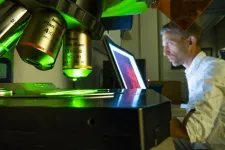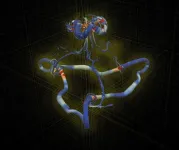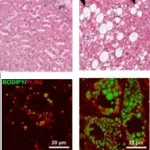(Press-News.org) Certain anchor proteins inhibit a key metabolic driver that plays an important role in cancer and developmental brain disorders. Scientists from the German Cancer Research Center (DKFZ) and the University of Innsbruck, together with a Europe-wide research network, discovered this molecular mechanism, which could open up new opportunities for personalized therapies for cancer and neuronal diseases. They published their results in the journal Cell.
The signaling protein MTOR (Mechanistic Target of Rapamycin) is a sensor for nutrients such as amino acids and sugars. When sufficient nutrients are available, MTOR boosts metabolism and ensures that sufficient energy and cellular building blocks are available. Since MTOR is a central switch for metabolism, errors in its activation lead to serious diseases. Cancers and developmental disorders of the nervous system leading to behavioral disorders and epilepsy can be the result if MTOR is malfunctioning.
Therefore, the cell controls MTOR activity very precisely with the help of so-called suppressors. These are molecules that inhibit a protein and help to regulate its activity. The-TSC complex is such a suppressor for MTOR. It is named after the disease that causes its absence - tuberous sclerosis (TSC). The TSC complex is located together with MTOR at small structures in the cell, the so-called lysosomes, where it keeps MTOR in check. If the TSC complex - for example due to changes in one of its components - no longer remains at the lysosome, this can lead to excessive MTOR activity with severe health consequences.
Protein with an anchor function
The teams led by Christiane Opitz at DKFZ and Kathrin Thedieck at the University of Innsbruck therefore investigated how the TSC complex binds to lysosomes. They discovered that the G3BP proteins (Ras GTPase-activating protein-binding protein) are located together with the TSC complex on lysosomes. "There, the G3BP proteins form an anchor that ensures that the TSC complex can bind to the lysosomes," explains Mirja Tamara Prentzell of DKFZ, first author of the publication. This anchor function plays a crucial role in breast cancer cells. If the amount of G3BP proteins is reduced in cell cultures, this not only leads to increased MTOR activity, but also increases cell migration.
Drugs that inhibit MTOR prevent this spread, the researchers were able to show in cell cultures. In breast cancer patients, low levels of G3BP correlate with a poorer prognosis. "Markers like the G3BP proteins could be helpful to personalize therapies based on inhibition of MTOR," explains Kathrin Thedieck, professor of biochemistry at the University of Innsbruck. The good thing is that drugs that inhibit MTOR are already approved as cancer drugs and could be tested specifically in further studies.
G3BP proteins also inhibit MTOR in the brain. In zebrafish, an important animal model, the researchers observed disturbances in brain development when G3BP is absent. This leads to neuronal hyperactivity similar to epilepsy in humans. These neuronal discharges could be suppressed by drugs that inhibit MTOR. "We therefore hope that patients with rare hereditary neurological diseases in which dysfunctions of the G3BP proteins play a role could benefit from drugs against MTOR," says Christiane Opitz of DKFZ. In the future, the scientists plan to investigate this together with their Europe-wide research network.
INFORMATION:
The authors of the current study received funding from the German Research Foundation and the European Union as part of the MESI-STRAT breast cancer consortium, the German Tuberous Sclerosis Foundation and the Dutch TSC Fund foundation, among others.
G3BPs tether the TSC complex to lysosomes and suppress mTORC1 signaling. Prentzell MT*, Rehbein U*, Cadena Sandoval M*, De Meulemeester A*, Baumeister R, Brohée L, Berdel B, Bockwoldt M, Carroll B, Chowdhury SR, von Deimling A, Demetriades C, Figlia G, Genomics England Research Consortium, Eca Guimaraes de Araujo M, Heberle AM, Heiland I, Holzwarth B, Huber LA, Jaworski J, Kedra M, Kern K, Kopach A, Korolchuk VI, van 't Land-Kuper I, Macias M, Nellist M, Palm W, Pusch S, Ramos Pittol JM, Reil M, Reintjes A, Reuter F, Sampson JR, Scheldeman C, Siekierska A, Stefan E, Teleman AA, Thomas LE, Torres-Quesada O, Trump S, West HD, de Witte P, Woltering S, Yordanov T, Zmorzynska J, Opitz CA#, Thedieck K#.
Cell 2021, DOI: https://doi.org/10.1016/j.cell.2020.12.024
All the cells in the human body share the same genes. But how our genes are expressed determines whether a cell becomes a brain cell or a liver cell. In addition, changes in gene expression often play a significant role in development of diseases.
One mechanism that contributes to the changes in gene expression is the interaction between the proteins called histones and enzymes known as HDACs. These enzymes help the cell divide and develop, which is the reason why they serve as targets for anti-cancer medicine: When you inhibit the enzymes, the cancer cells will stop dividing and growing further.
Despite being targets for clinically approved medicines, researchers do not know all the details of how they ...
Special immune cells found in the brain, microglia, play a key role in the processes that make you feel uneasy and depressed in correlation with inflammation. This is the conclusion of a study using mice carried out by researchers at Linköping University, Sweden. The results have been published in the scientific journal Immunity, and suggest that microglial cells contribute to the negative mood experienced during several neurological diseases, and maybe also depression.
David Engblom's research group at Linköping University has spent many years looking at why inflammation in the body, such as a common cold or influenza, causes us to feel poorly ...
Artificial intelligence and automation are changing the world, one industry at a time! Whatever humans can do, machines are learning to also do effectively, with lower costs and fewer errors. The maritime shipping industry is no different. Ships are now increasingly automated (called maritime autonomous surface ships or MASSs), reducing the need for human input. While this bodes well for labor and fuel costs, the question naturally raised is, what happens to the jobs of seafarers, the chief workforce of the shipping industry, once MASSs take over.
To find out, researchers from Korea used complex mathematical models and simulations ...
RESEARCH TRIANGLE PARK, N.C. -- Design of Army aerial vehicles and weapon systems relies on the ability to predict aerodynamic behavior, often aided by advanced computer simulations of the flow of air over the body. High-fidelity simulations assist engineers in maximizing how much load a rotorcraft can lift or how far a missile can fly, but these simulations aren't cheap.
The simulations that designers currently use require extensive data processing on supercomputers and capture only a portion of vortex collision events - which can cause significant performance degradation, from loss of lift on a rotor to complete loss of control of a munition. A new turbulence model could change that.
The Army Research Office, an ...
Teenagers with happy childhood memories are likely to drink less, take fewer drugs and enjoy learning, according to research published in the peer-reviewed journal END ...
New Orleans, LA - An analysis by Nicholas Gilpin, PhD, Professor of Physiology and Associate Director of the Alcohol and Drug Abuse Center of Excellence at LSU Health New Orleans School of Medicine, and Michael Taffe, PhD, Professor of Psychiatry at the University of California San Diego, summarizes long-standing racial inequities in federal funding for biosciences research from the National Institutes of Health (NIH). Their report describes prior failures to correct these racial inequities and offers strategies that may be effective in eliminating these disparities. Their paper, published online in the open-access ...
Nonalcoholic fatty liver disease (NAFLD) is a widespread condition in the Western World. Around 30% of the population have lipid droplets stored in their liver which diminish its function in the long term. Main causes for NAFLD are our high-caloric diet in combination with a sedentary lifestyle. Hitherto, researchers have not fully understood the cause of this disease and despite the high number of affected individuals, there is no approved therapy.
In order to improve our understanding of the basic mechanisms underlying the etiology of NAFLD, Dr. Nina Graffmann, Prof. James Adjaye and the team of the Institute for Stem Cell research and Regenerative Medicine from the University Hospital Duesseldorf differentiated induced pluripotent stem cells (iPSCs) derived from healthy ...
Using a combination of telescopes, including the Very Large Telescope of the European Southern Observatory (ESO's VLT), astronomers have revealed a system consisting of six exoplanets, five of which are locked in a rare rhythm around their central star. The researchers believe the system could provide important clues about how planets, including those in the Solar System, form and evolve.
The first time the team observed TOI-178, a star some 200 light-years away in the constellation of Sculptor, they thought they had spotted two planets going around it in the same orbit. However, a closer look revealed something entirely ...
CHICAGO (January 25, 2021; 9 am CST): A new study finds that older cancer patients are less likely to have optimal results following their cancer operation if they live in an area highly affected by social challenges, especially if they are racial-ethnic minorities. The study was selected for the 2020 Southern Surgical Association Program and published as an "article in press" on the Journal of the American College of Surgeons website in advance of print.
Study investigators from The Ohio State University (OSU) used a novel risk stratification tool called the social vulnerability index (SVI), a composite measure of 15 social and economic factors. ...
The key factor in preventing non-communicable diseases is lifestyle management at the individual level with a focus on such innovations, which can help increase the awareness of risk factors management in society, claim an international team of researchers, among them - scientists from Kaunas University of Technology (KTU), Lithuania in a recent study. According to them, the management of cancer, diabetes, cardiovascular and respiratory diseases requires many strategies from several perspectives and on different levels.
Non-communicable diseases (NCDs), also known as chronic diseases, are medical conditions that are ...





